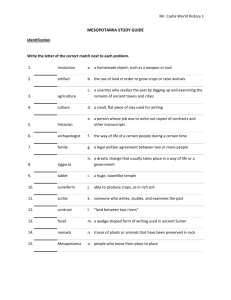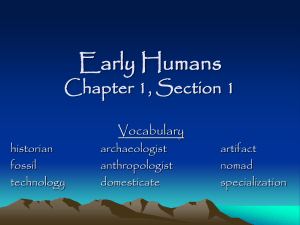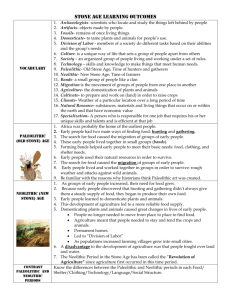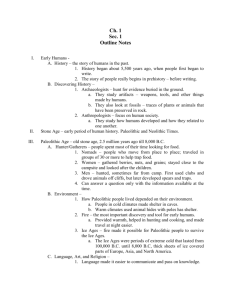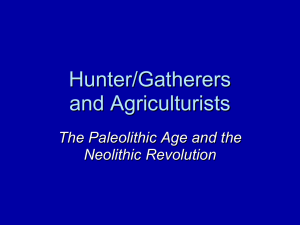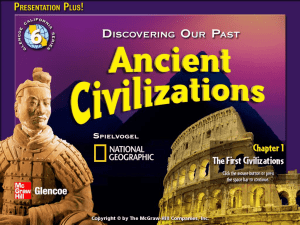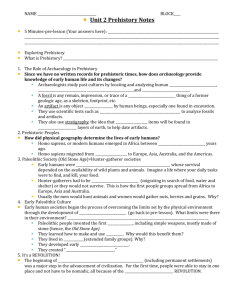Early Humans: Key Terms - Mrs. McLaughlin`s 6th Grade Block
advertisement
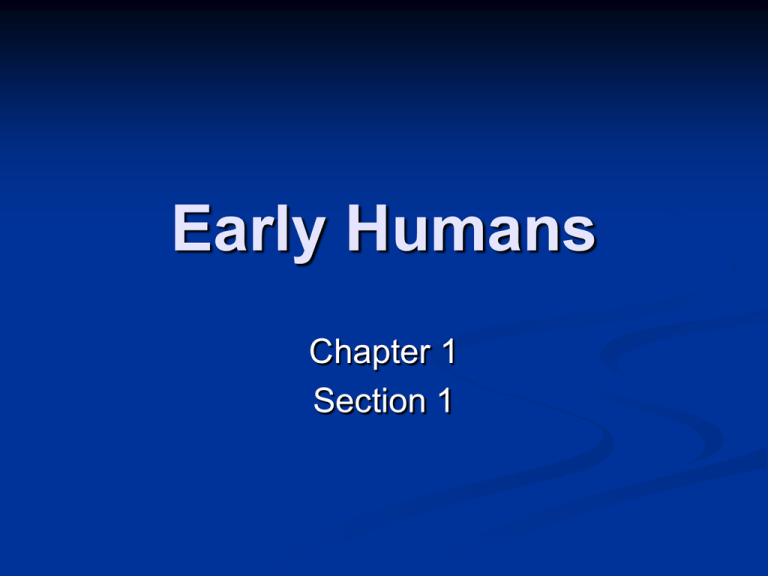
Early Humans Chapter 1 Section 1 Early Humans: Key Terms History is the story of humans in the past, and historians are the people who study and write about humans of the past. Anthropologists study how humans developed and related to each other. Archaeologists hunt for evidence buried in the ground. The prehistoric period of human history is called the Stone Age. They study artifacts: weapons, tools, and other things made by humans. They look for fossils: traces of plants or animals that are preserved in rock. The earliest part of the Stone Age is called the Paleolithic period. Paleolithic people were nomads, traveling from place to place to hunt and search for food. Early Humans: Famous People Louis, Mary, and Richard Leakey are the most famous archaeologists. They found many fossils of hominids, which are creatures that walk on two legs. Mary discovered the skull of a hominid that was nearly 2 million years old. Donald Johanson was an anthropologist who discovered a female hominid that was nearly 3 million years old. Lucy! This told us that humans began walking on 2 legs before they used tools. Early Humans: Notes Paleolithic women: cared for children and gathered berries, nuts, and grains. Paleolithic men: hunted animals using clubs, spears, traps, and bows and arrows. Paleolithic people adapted to their environment. Paleolithic people discovered fire, which kept them warm, lit the darkness, and cooked. Long periods of extreme cold are called the Ice Ages. Those in warm climates wore little clothing and had little need for shelter. Those in cold climates used caves for shelter. Over time, they learned to create shelters from animal hides and wooden poles. Thick sheets of ice covered Europe, Asia, and North America. Paleolithic people developed spoken language and expressed themselves through art, which may have had religious meaning. During this time, humans first used technology. They created tools such as spears and hand axes using stone called flint. Discussion Question How did spoken language help the Paleolithic people? Language made it easier for people to work together and pass on knowledge. Agricultural Revolution In the Mesolithic Age, people began to domesticate, or tame, animals. People in different parts of the world began growing crops about the same time. Domesticated animals carried goods and provided meat, milk, and wool. Farmers need to stay close to their fields, so they built permanent homes in villages. This marked the beginning of the Neolithic Age. Historians call the changes made in the Neolithic Age the agricultural revolution. A revolution refers to changes that greatly affect other areas of life. Agricultural Revolution Permanent villages provided people with security and steady food. One of the oldest villages is Jericho. Located in present-day Turkey. Not all people in a village were farmers. Located between present-day Israel and Jordan. Another Neolithic village is Catal Huyuk. Surplus food led to a larger population. Villages also made it easier for diseases to spread among people. Some made pottery, mats, and cloth. They traded these goods for things they did not have. The food surplus allowed people to practice these specializations: different kinds of jobs. People continued to create new technology. They created better farming tools and began working with metal, copper, and tin. Discussion Question Why was farming important to the Neolithic people? Farming allowed people to settle in one place, and it provided a steady food supply. They were no longer hunter-gatherers or nomads. Did You Know? Scientists believe early humans made tools from other materials besides stone. They probably used wooden sticks to dig holes and used bark from trees to make containers. Unlike stone, these organic materials decay, so remnants from the early humans are unavailable. Therefore, this is based on assumption and theory.

